Taxation Law: SBE Definition, Treatment, and Government Policies
VerifiedAdded on 2022/11/01
|15
|4013
|393
Report
AI Summary
This report delves into the intricacies of Small Business Entity (SBE) taxation in Australia. It begins by defining the criteria for SBE status, as outlined by the Australian Taxation Office (ATO), including turnover thresholds and business structure requirements. The report then explores the favorable tax treatment afforded to SBEs, examining the rationale behind these concessions, such as the need to support smaller businesses in a competitive economic landscape. It emphasizes the importance of correctly identifying SBEs to ensure both government revenue and fair application of tax benefits. The report outlines the planning taxpayers undertake to ensure they qualify as an SBE, referencing the ATO's guidance and relevant taxation rulings. It also details the significant advantages available to qualifying entities, such as special GST installments, income tax offsets, and simplified trading stock rules. Finally, the report examines significant events and government policies impacting SBE tax treatment in Australia, including proposed corporate tax rate reductions and other legislative changes designed to support small businesses.
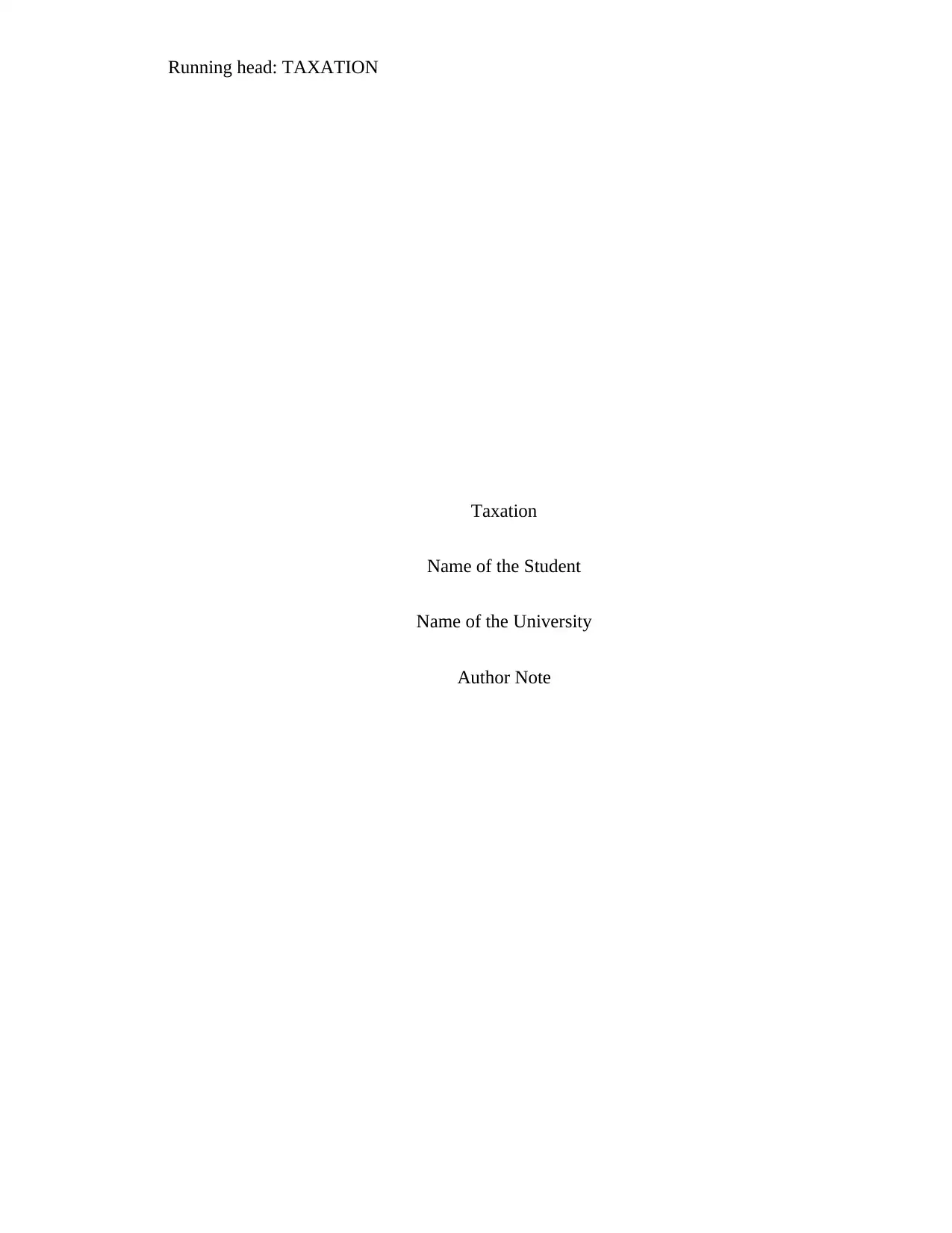
Running head: TAXATION
Taxation
Name of the Student
Name of the University
Author Note
Taxation
Name of the Student
Name of the University
Author Note
Paraphrase This Document
Need a fresh take? Get an instant paraphrase of this document with our AI Paraphraser
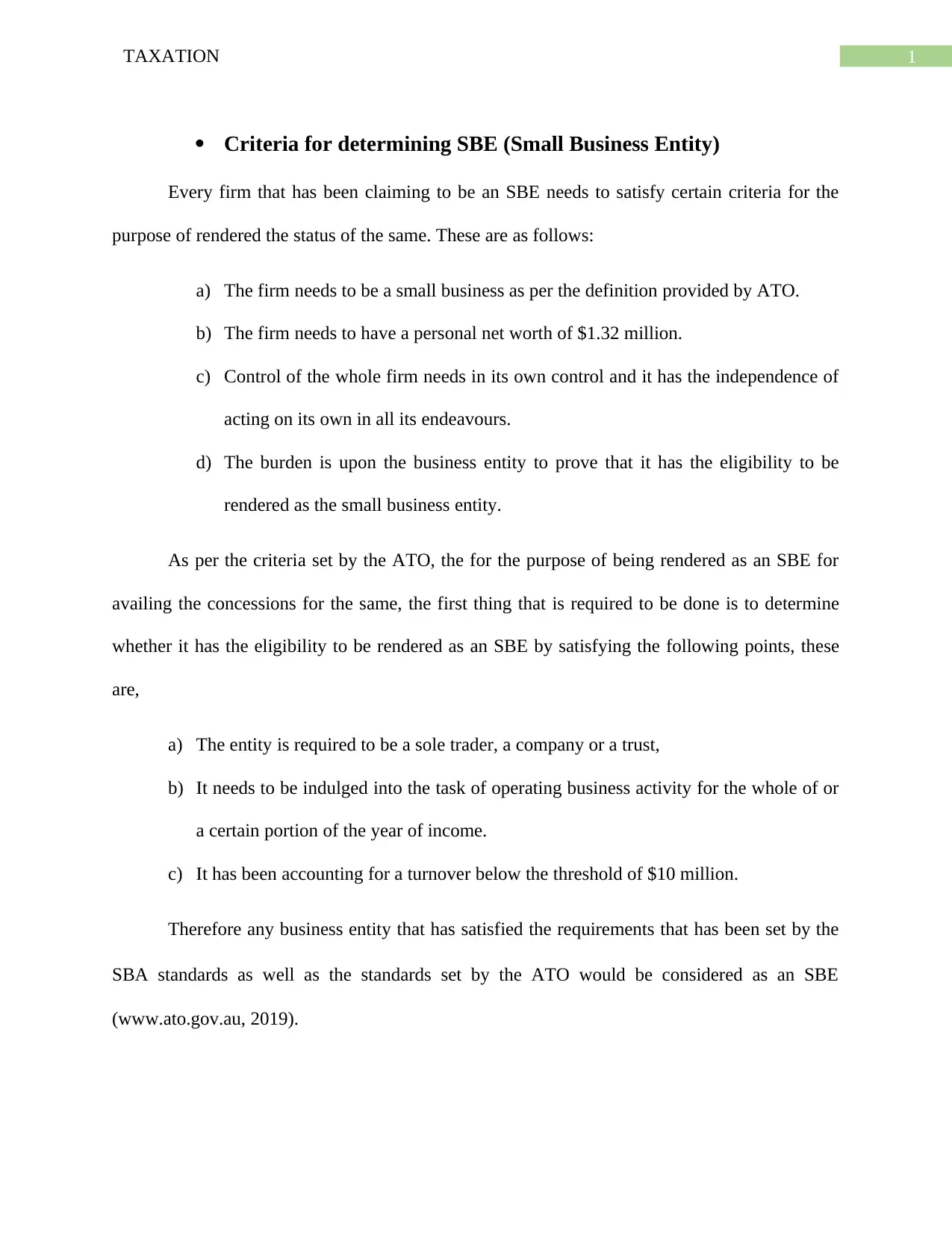
1TAXATION
Criteria for determining SBE (Small Business Entity)
Every firm that has been claiming to be an SBE needs to satisfy certain criteria for the
purpose of rendered the status of the same. These are as follows:
a) The firm needs to be a small business as per the definition provided by ATO.
b) The firm needs to have a personal net worth of $1.32 million.
c) Control of the whole firm needs in its own control and it has the independence of
acting on its own in all its endeavours.
d) The burden is upon the business entity to prove that it has the eligibility to be
rendered as the small business entity.
As per the criteria set by the ATO, the for the purpose of being rendered as an SBE for
availing the concessions for the same, the first thing that is required to be done is to determine
whether it has the eligibility to be rendered as an SBE by satisfying the following points, these
are,
a) The entity is required to be a sole trader, a company or a trust,
b) It needs to be indulged into the task of operating business activity for the whole of or
a certain portion of the year of income.
c) It has been accounting for a turnover below the threshold of $10 million.
Therefore any business entity that has satisfied the requirements that has been set by the
SBA standards as well as the standards set by the ATO would be considered as an SBE
(www.ato.gov.au, 2019).
Criteria for determining SBE (Small Business Entity)
Every firm that has been claiming to be an SBE needs to satisfy certain criteria for the
purpose of rendered the status of the same. These are as follows:
a) The firm needs to be a small business as per the definition provided by ATO.
b) The firm needs to have a personal net worth of $1.32 million.
c) Control of the whole firm needs in its own control and it has the independence of
acting on its own in all its endeavours.
d) The burden is upon the business entity to prove that it has the eligibility to be
rendered as the small business entity.
As per the criteria set by the ATO, the for the purpose of being rendered as an SBE for
availing the concessions for the same, the first thing that is required to be done is to determine
whether it has the eligibility to be rendered as an SBE by satisfying the following points, these
are,
a) The entity is required to be a sole trader, a company or a trust,
b) It needs to be indulged into the task of operating business activity for the whole of or
a certain portion of the year of income.
c) It has been accounting for a turnover below the threshold of $10 million.
Therefore any business entity that has satisfied the requirements that has been set by the
SBA standards as well as the standards set by the ATO would be considered as an SBE
(www.ato.gov.au, 2019).
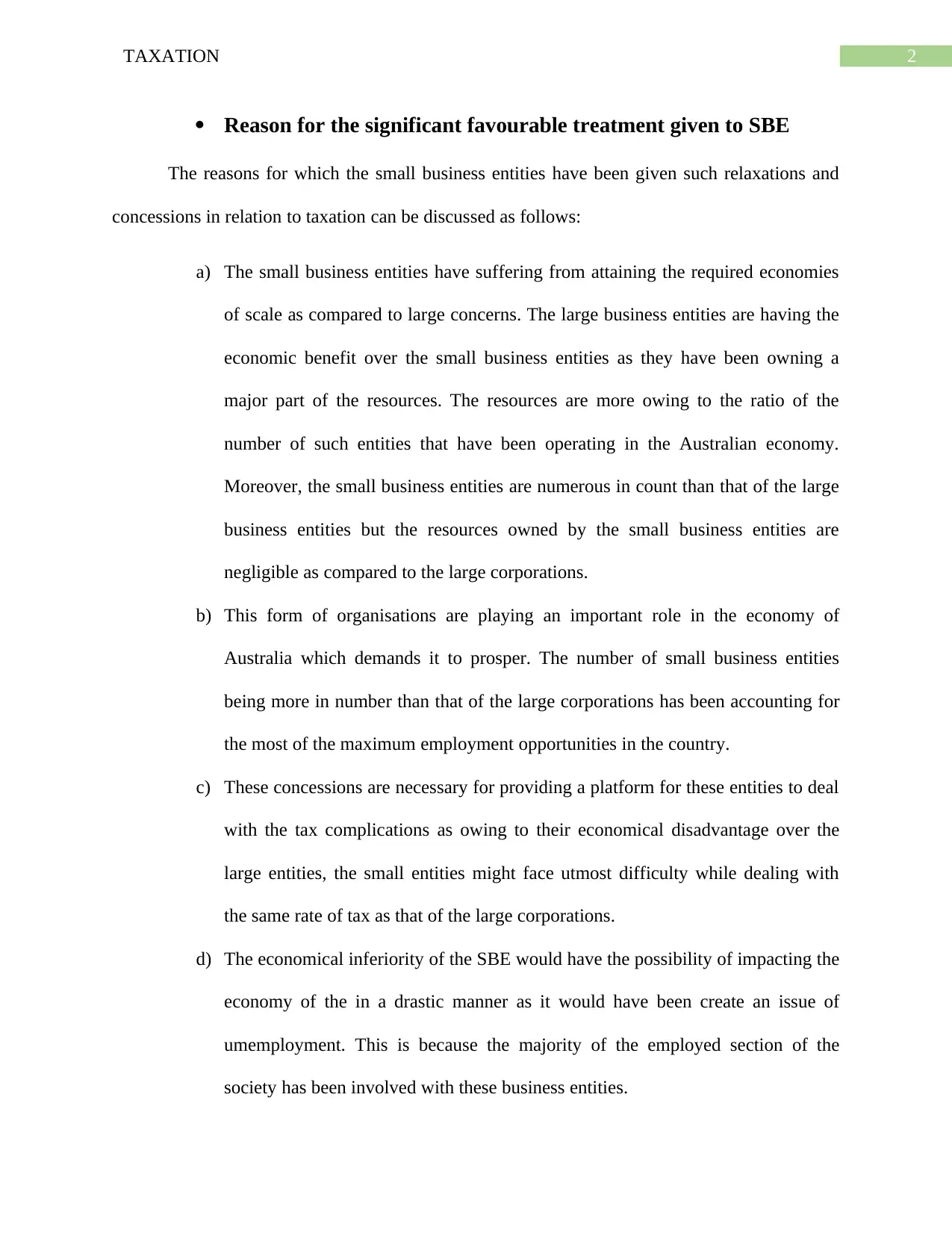
2TAXATION
Reason for the significant favourable treatment given to SBE
The reasons for which the small business entities have been given such relaxations and
concessions in relation to taxation can be discussed as follows:
a) The small business entities have suffering from attaining the required economies
of scale as compared to large concerns. The large business entities are having the
economic benefit over the small business entities as they have been owning a
major part of the resources. The resources are more owing to the ratio of the
number of such entities that have been operating in the Australian economy.
Moreover, the small business entities are numerous in count than that of the large
business entities but the resources owned by the small business entities are
negligible as compared to the large corporations.
b) This form of organisations are playing an important role in the economy of
Australia which demands it to prosper. The number of small business entities
being more in number than that of the large corporations has been accounting for
the most of the maximum employment opportunities in the country.
c) These concessions are necessary for providing a platform for these entities to deal
with the tax complications as owing to their economical disadvantage over the
large entities, the small entities might face utmost difficulty while dealing with
the same rate of tax as that of the large corporations.
d) The economical inferiority of the SBE would have the possibility of impacting the
economy of the in a drastic manner as it would have been create an issue of
umemployment. This is because the majority of the employed section of the
society has been involved with these business entities.
Reason for the significant favourable treatment given to SBE
The reasons for which the small business entities have been given such relaxations and
concessions in relation to taxation can be discussed as follows:
a) The small business entities have suffering from attaining the required economies
of scale as compared to large concerns. The large business entities are having the
economic benefit over the small business entities as they have been owning a
major part of the resources. The resources are more owing to the ratio of the
number of such entities that have been operating in the Australian economy.
Moreover, the small business entities are numerous in count than that of the large
business entities but the resources owned by the small business entities are
negligible as compared to the large corporations.
b) This form of organisations are playing an important role in the economy of
Australia which demands it to prosper. The number of small business entities
being more in number than that of the large corporations has been accounting for
the most of the maximum employment opportunities in the country.
c) These concessions are necessary for providing a platform for these entities to deal
with the tax complications as owing to their economical disadvantage over the
large entities, the small entities might face utmost difficulty while dealing with
the same rate of tax as that of the large corporations.
d) The economical inferiority of the SBE would have the possibility of impacting the
economy of the in a drastic manner as it would have been create an issue of
umemployment. This is because the majority of the employed section of the
society has been involved with these business entities.
⊘ This is a preview!⊘
Do you want full access?
Subscribe today to unlock all pages.

Trusted by 1+ million students worldwide
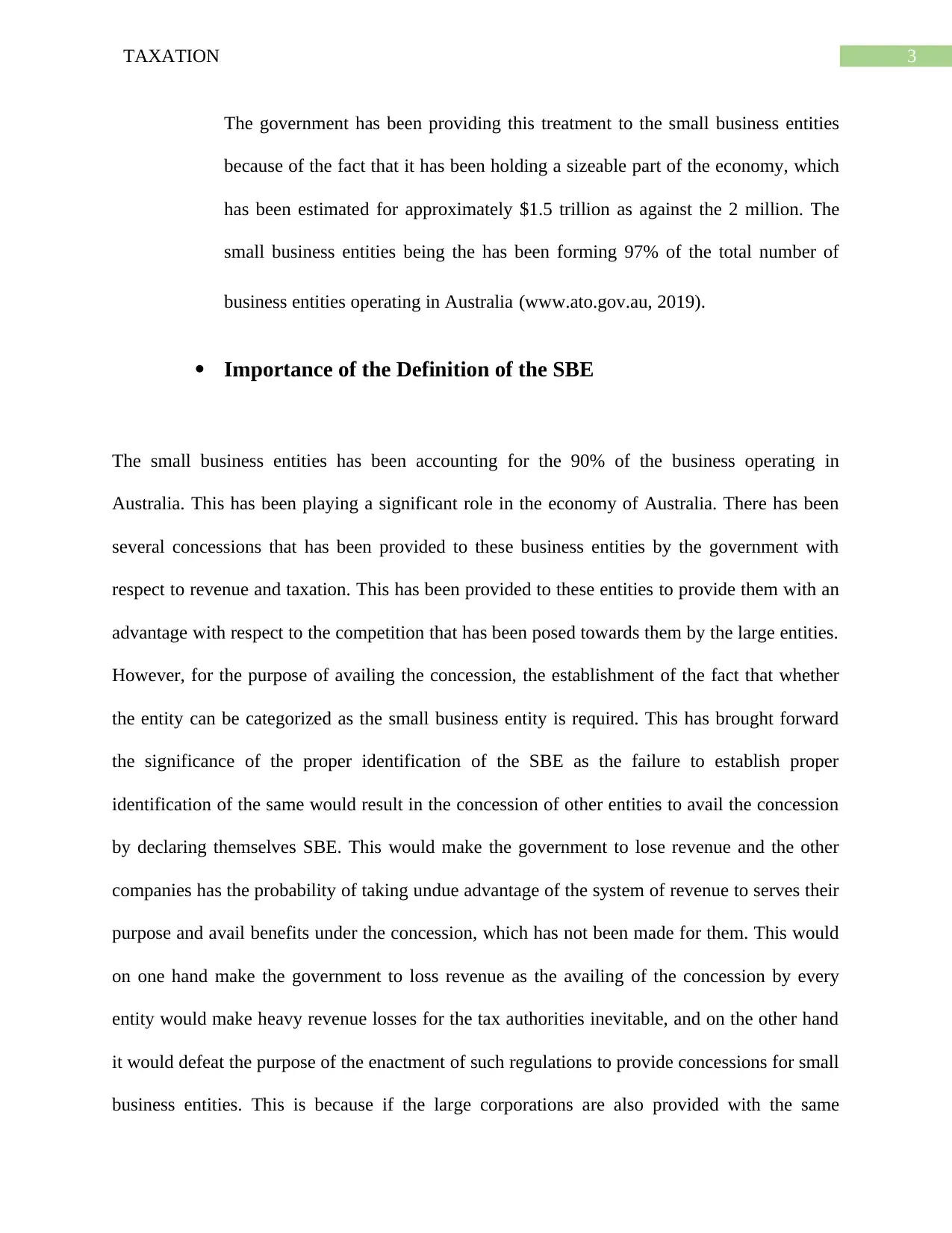
3TAXATION
The government has been providing this treatment to the small business entities
because of the fact that it has been holding a sizeable part of the economy, which
has been estimated for approximately $1.5 trillion as against the 2 million. The
small business entities being the has been forming 97% of the total number of
business entities operating in Australia (www.ato.gov.au, 2019).
Importance of the Definition of the SBE
The small business entities has been accounting for the 90% of the business operating in
Australia. This has been playing a significant role in the economy of Australia. There has been
several concessions that has been provided to these business entities by the government with
respect to revenue and taxation. This has been provided to these entities to provide them with an
advantage with respect to the competition that has been posed towards them by the large entities.
However, for the purpose of availing the concession, the establishment of the fact that whether
the entity can be categorized as the small business entity is required. This has brought forward
the significance of the proper identification of the SBE as the failure to establish proper
identification of the same would result in the concession of other entities to avail the concession
by declaring themselves SBE. This would make the government to lose revenue and the other
companies has the probability of taking undue advantage of the system of revenue to serves their
purpose and avail benefits under the concession, which has not been made for them. This would
on one hand make the government to loss revenue as the availing of the concession by every
entity would make heavy revenue losses for the tax authorities inevitable, and on the other hand
it would defeat the purpose of the enactment of such regulations to provide concessions for small
business entities. This is because if the large corporations are also provided with the same
The government has been providing this treatment to the small business entities
because of the fact that it has been holding a sizeable part of the economy, which
has been estimated for approximately $1.5 trillion as against the 2 million. The
small business entities being the has been forming 97% of the total number of
business entities operating in Australia (www.ato.gov.au, 2019).
Importance of the Definition of the SBE
The small business entities has been accounting for the 90% of the business operating in
Australia. This has been playing a significant role in the economy of Australia. There has been
several concessions that has been provided to these business entities by the government with
respect to revenue and taxation. This has been provided to these entities to provide them with an
advantage with respect to the competition that has been posed towards them by the large entities.
However, for the purpose of availing the concession, the establishment of the fact that whether
the entity can be categorized as the small business entity is required. This has brought forward
the significance of the proper identification of the SBE as the failure to establish proper
identification of the same would result in the concession of other entities to avail the concession
by declaring themselves SBE. This would make the government to lose revenue and the other
companies has the probability of taking undue advantage of the system of revenue to serves their
purpose and avail benefits under the concession, which has not been made for them. This would
on one hand make the government to loss revenue as the availing of the concession by every
entity would make heavy revenue losses for the tax authorities inevitable, and on the other hand
it would defeat the purpose of the enactment of such regulations to provide concessions for small
business entities. This is because if the large corporations are also provided with the same
Paraphrase This Document
Need a fresh take? Get an instant paraphrase of this document with our AI Paraphraser
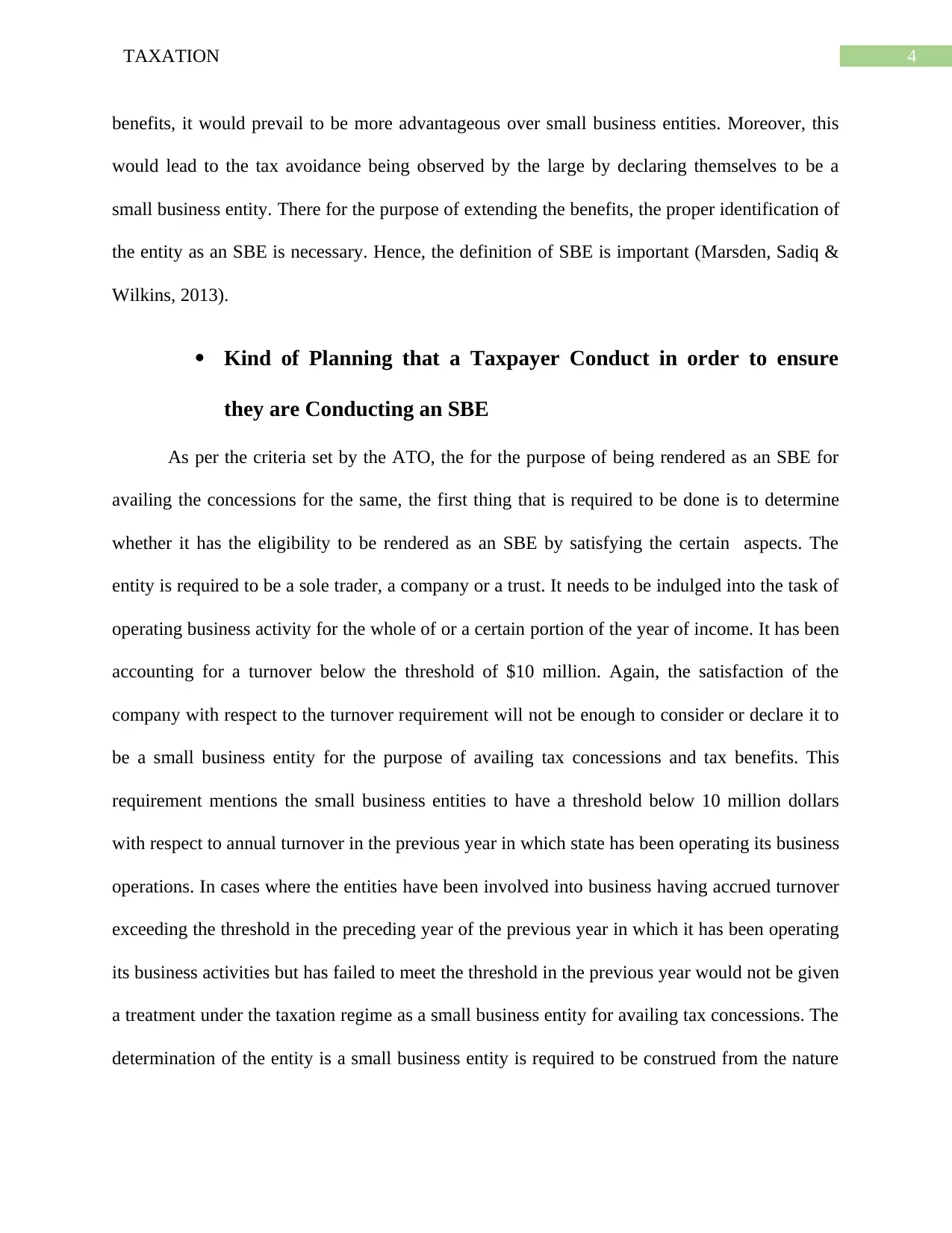
4TAXATION
benefits, it would prevail to be more advantageous over small business entities. Moreover, this
would lead to the tax avoidance being observed by the large by declaring themselves to be a
small business entity. There for the purpose of extending the benefits, the proper identification of
the entity as an SBE is necessary. Hence, the definition of SBE is important (Marsden, Sadiq &
Wilkins, 2013).
Kind of Planning that a Taxpayer Conduct in order to ensure
they are Conducting an SBE
As per the criteria set by the ATO, the for the purpose of being rendered as an SBE for
availing the concessions for the same, the first thing that is required to be done is to determine
whether it has the eligibility to be rendered as an SBE by satisfying the certain aspects. The
entity is required to be a sole trader, a company or a trust. It needs to be indulged into the task of
operating business activity for the whole of or a certain portion of the year of income. It has been
accounting for a turnover below the threshold of $10 million. Again, the satisfaction of the
company with respect to the turnover requirement will not be enough to consider or declare it to
be a small business entity for the purpose of availing tax concessions and tax benefits. This
requirement mentions the small business entities to have a threshold below 10 million dollars
with respect to annual turnover in the previous year in which state has been operating its business
operations. In cases where the entities have been involved into business having accrued turnover
exceeding the threshold in the preceding year of the previous year in which it has been operating
its business activities but has failed to meet the threshold in the previous year would not be given
a treatment under the taxation regime as a small business entity for availing tax concessions. The
determination of the entity is a small business entity is required to be construed from the nature
benefits, it would prevail to be more advantageous over small business entities. Moreover, this
would lead to the tax avoidance being observed by the large by declaring themselves to be a
small business entity. There for the purpose of extending the benefits, the proper identification of
the entity as an SBE is necessary. Hence, the definition of SBE is important (Marsden, Sadiq &
Wilkins, 2013).
Kind of Planning that a Taxpayer Conduct in order to ensure
they are Conducting an SBE
As per the criteria set by the ATO, the for the purpose of being rendered as an SBE for
availing the concessions for the same, the first thing that is required to be done is to determine
whether it has the eligibility to be rendered as an SBE by satisfying the certain aspects. The
entity is required to be a sole trader, a company or a trust. It needs to be indulged into the task of
operating business activity for the whole of or a certain portion of the year of income. It has been
accounting for a turnover below the threshold of $10 million. Again, the satisfaction of the
company with respect to the turnover requirement will not be enough to consider or declare it to
be a small business entity for the purpose of availing tax concessions and tax benefits. This
requirement mentions the small business entities to have a threshold below 10 million dollars
with respect to annual turnover in the previous year in which state has been operating its business
operations. In cases where the entities have been involved into business having accrued turnover
exceeding the threshold in the preceding year of the previous year in which it has been operating
its business activities but has failed to meet the threshold in the previous year would not be given
a treatment under the taxation regime as a small business entity for availing tax concessions. The
determination of the entity is a small business entity is required to be construed from the nature
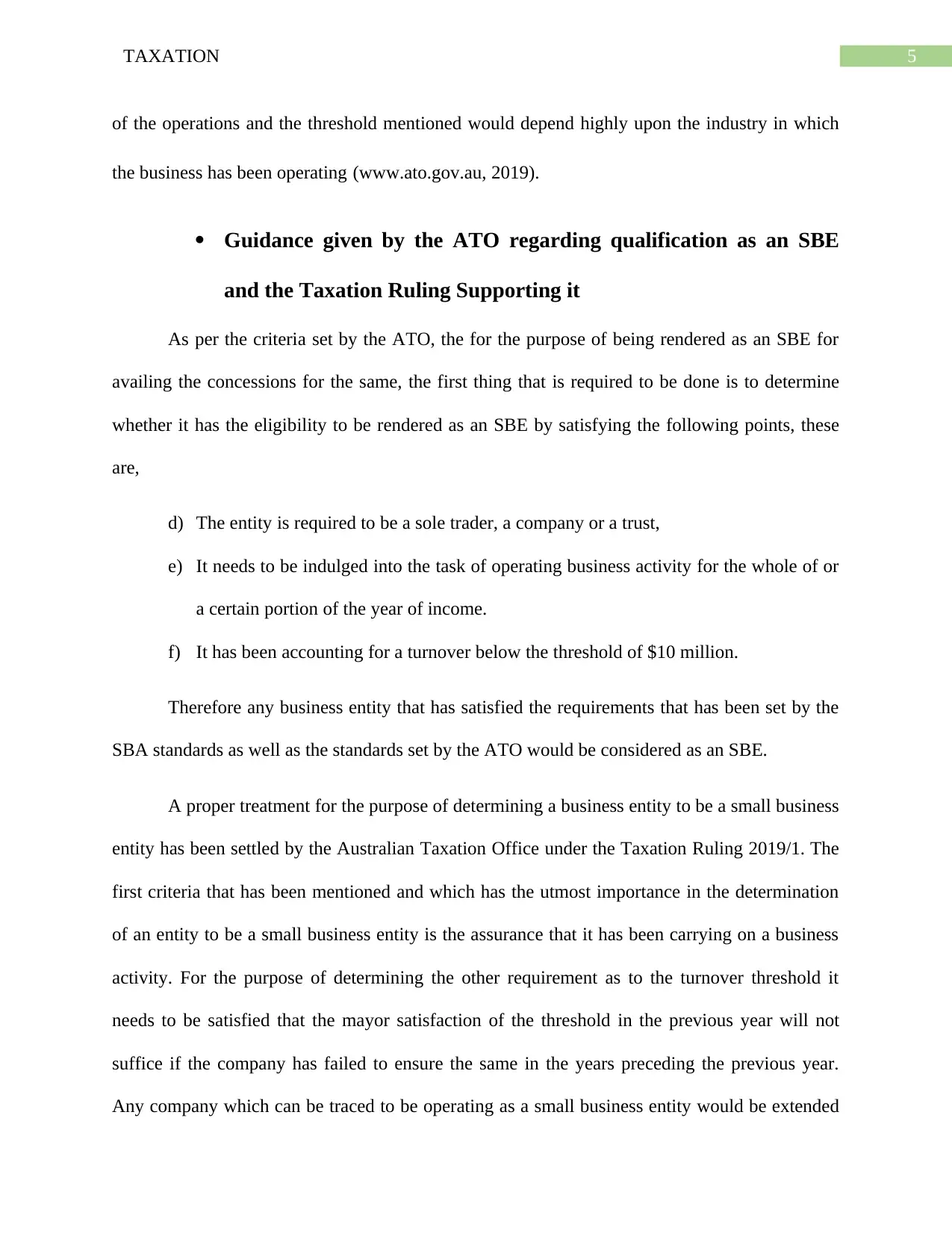
5TAXATION
of the operations and the threshold mentioned would depend highly upon the industry in which
the business has been operating (www.ato.gov.au, 2019).
Guidance given by the ATO regarding qualification as an SBE
and the Taxation Ruling Supporting it
As per the criteria set by the ATO, the for the purpose of being rendered as an SBE for
availing the concessions for the same, the first thing that is required to be done is to determine
whether it has the eligibility to be rendered as an SBE by satisfying the following points, these
are,
d) The entity is required to be a sole trader, a company or a trust,
e) It needs to be indulged into the task of operating business activity for the whole of or
a certain portion of the year of income.
f) It has been accounting for a turnover below the threshold of $10 million.
Therefore any business entity that has satisfied the requirements that has been set by the
SBA standards as well as the standards set by the ATO would be considered as an SBE.
A proper treatment for the purpose of determining a business entity to be a small business
entity has been settled by the Australian Taxation Office under the Taxation Ruling 2019/1. The
first criteria that has been mentioned and which has the utmost importance in the determination
of an entity to be a small business entity is the assurance that it has been carrying on a business
activity. For the purpose of determining the other requirement as to the turnover threshold it
needs to be satisfied that the mayor satisfaction of the threshold in the previous year will not
suffice if the company has failed to ensure the same in the years preceding the previous year.
Any company which can be traced to be operating as a small business entity would be extended
of the operations and the threshold mentioned would depend highly upon the industry in which
the business has been operating (www.ato.gov.au, 2019).
Guidance given by the ATO regarding qualification as an SBE
and the Taxation Ruling Supporting it
As per the criteria set by the ATO, the for the purpose of being rendered as an SBE for
availing the concessions for the same, the first thing that is required to be done is to determine
whether it has the eligibility to be rendered as an SBE by satisfying the following points, these
are,
d) The entity is required to be a sole trader, a company or a trust,
e) It needs to be indulged into the task of operating business activity for the whole of or
a certain portion of the year of income.
f) It has been accounting for a turnover below the threshold of $10 million.
Therefore any business entity that has satisfied the requirements that has been set by the
SBA standards as well as the standards set by the ATO would be considered as an SBE.
A proper treatment for the purpose of determining a business entity to be a small business
entity has been settled by the Australian Taxation Office under the Taxation Ruling 2019/1. The
first criteria that has been mentioned and which has the utmost importance in the determination
of an entity to be a small business entity is the assurance that it has been carrying on a business
activity. For the purpose of determining the other requirement as to the turnover threshold it
needs to be satisfied that the mayor satisfaction of the threshold in the previous year will not
suffice if the company has failed to ensure the same in the years preceding the previous year.
Any company which can be traced to be operating as a small business entity would be extended
⊘ This is a preview!⊘
Do you want full access?
Subscribe today to unlock all pages.

Trusted by 1+ million students worldwide
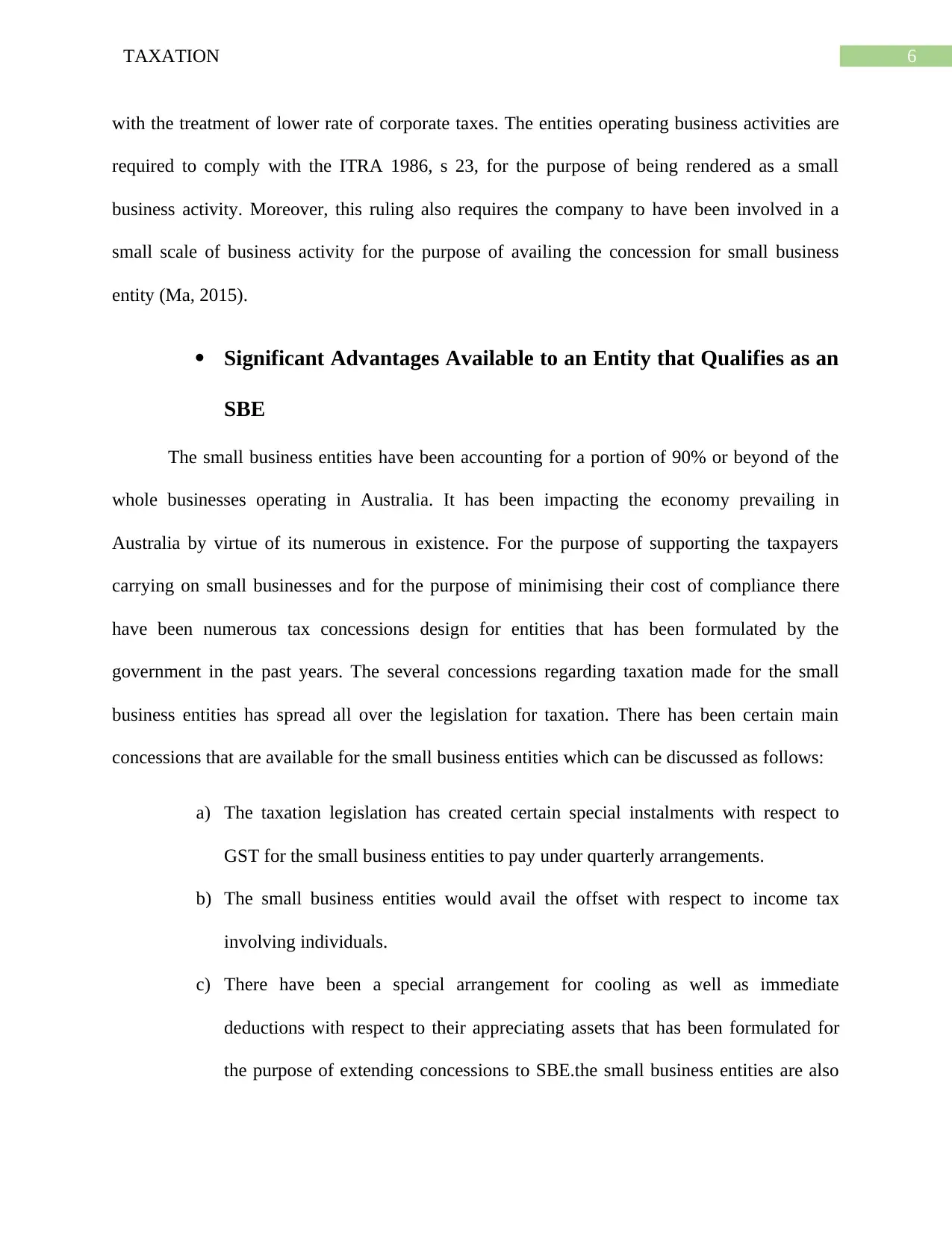
6TAXATION
with the treatment of lower rate of corporate taxes. The entities operating business activities are
required to comply with the ITRA 1986, s 23, for the purpose of being rendered as a small
business activity. Moreover, this ruling also requires the company to have been involved in a
small scale of business activity for the purpose of availing the concession for small business
entity (Ma, 2015).
Significant Advantages Available to an Entity that Qualifies as an
SBE
The small business entities have been accounting for a portion of 90% or beyond of the
whole businesses operating in Australia. It has been impacting the economy prevailing in
Australia by virtue of its numerous in existence. For the purpose of supporting the taxpayers
carrying on small businesses and for the purpose of minimising their cost of compliance there
have been numerous tax concessions design for entities that has been formulated by the
government in the past years. The several concessions regarding taxation made for the small
business entities has spread all over the legislation for taxation. There has been certain main
concessions that are available for the small business entities which can be discussed as follows:
a) The taxation legislation has created certain special instalments with respect to
GST for the small business entities to pay under quarterly arrangements.
b) The small business entities would avail the offset with respect to income tax
involving individuals.
c) There have been a special arrangement for cooling as well as immediate
deductions with respect to their appreciating assets that has been formulated for
the purpose of extending concessions to SBE.the small business entities are also
with the treatment of lower rate of corporate taxes. The entities operating business activities are
required to comply with the ITRA 1986, s 23, for the purpose of being rendered as a small
business activity. Moreover, this ruling also requires the company to have been involved in a
small scale of business activity for the purpose of availing the concession for small business
entity (Ma, 2015).
Significant Advantages Available to an Entity that Qualifies as an
SBE
The small business entities have been accounting for a portion of 90% or beyond of the
whole businesses operating in Australia. It has been impacting the economy prevailing in
Australia by virtue of its numerous in existence. For the purpose of supporting the taxpayers
carrying on small businesses and for the purpose of minimising their cost of compliance there
have been numerous tax concessions design for entities that has been formulated by the
government in the past years. The several concessions regarding taxation made for the small
business entities has spread all over the legislation for taxation. There has been certain main
concessions that are available for the small business entities which can be discussed as follows:
a) The taxation legislation has created certain special instalments with respect to
GST for the small business entities to pay under quarterly arrangements.
b) The small business entities would avail the offset with respect to income tax
involving individuals.
c) There have been a special arrangement for cooling as well as immediate
deductions with respect to their appreciating assets that has been formulated for
the purpose of extending concessions to SBE.the small business entities are also
Paraphrase This Document
Need a fresh take? Get an instant paraphrase of this document with our AI Paraphraser
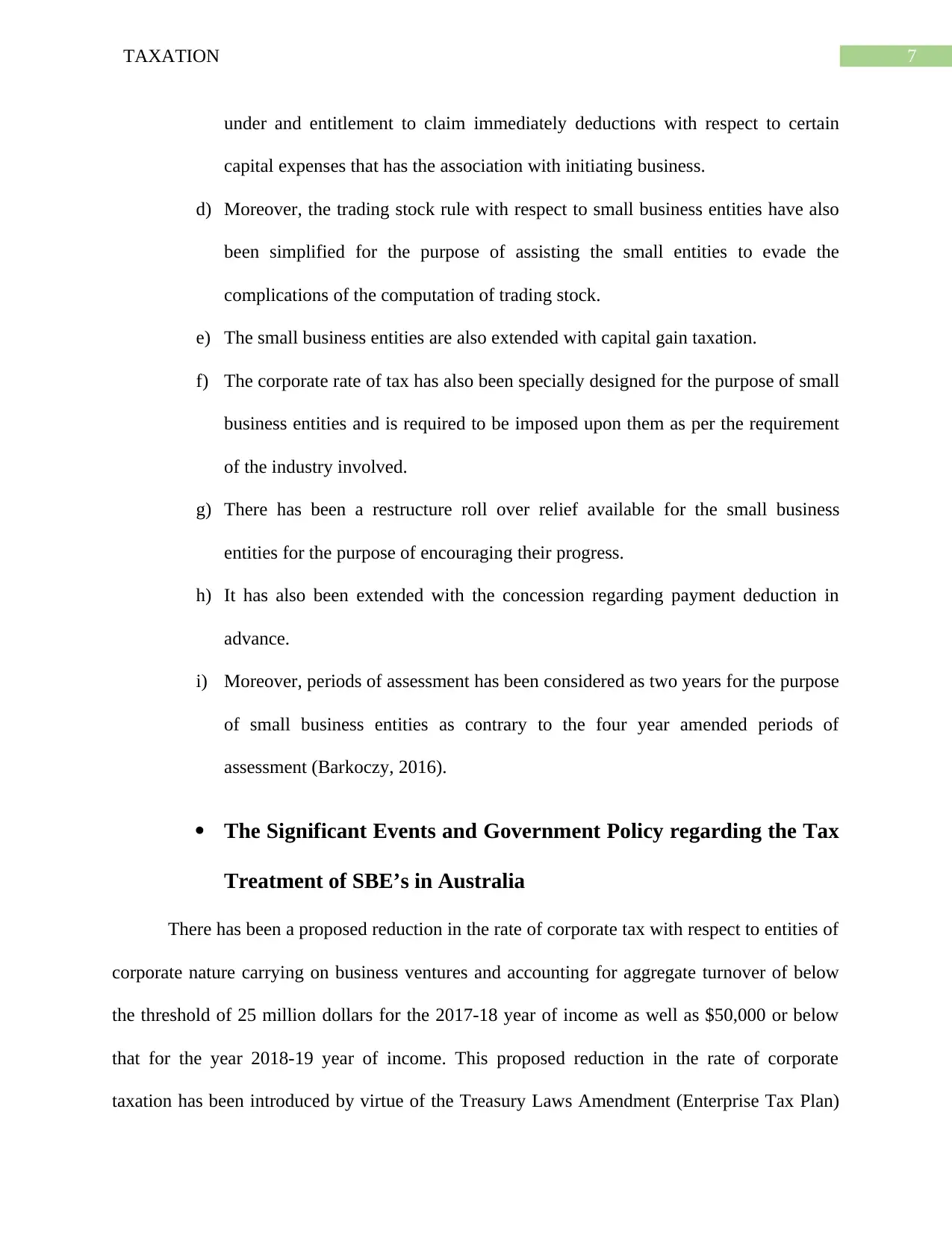
7TAXATION
under and entitlement to claim immediately deductions with respect to certain
capital expenses that has the association with initiating business.
d) Moreover, the trading stock rule with respect to small business entities have also
been simplified for the purpose of assisting the small entities to evade the
complications of the computation of trading stock.
e) The small business entities are also extended with capital gain taxation.
f) The corporate rate of tax has also been specially designed for the purpose of small
business entities and is required to be imposed upon them as per the requirement
of the industry involved.
g) There has been a restructure roll over relief available for the small business
entities for the purpose of encouraging their progress.
h) It has also been extended with the concession regarding payment deduction in
advance.
i) Moreover, periods of assessment has been considered as two years for the purpose
of small business entities as contrary to the four year amended periods of
assessment (Barkoczy, 2016).
The Significant Events and Government Policy regarding the Tax
Treatment of SBE’s in Australia
There has been a proposed reduction in the rate of corporate tax with respect to entities of
corporate nature carrying on business ventures and accounting for aggregate turnover of below
the threshold of 25 million dollars for the 2017-18 year of income as well as $50,000 or below
that for the year 2018-19 year of income. This proposed reduction in the rate of corporate
taxation has been introduced by virtue of the Treasury Laws Amendment (Enterprise Tax Plan)
under and entitlement to claim immediately deductions with respect to certain
capital expenses that has the association with initiating business.
d) Moreover, the trading stock rule with respect to small business entities have also
been simplified for the purpose of assisting the small entities to evade the
complications of the computation of trading stock.
e) The small business entities are also extended with capital gain taxation.
f) The corporate rate of tax has also been specially designed for the purpose of small
business entities and is required to be imposed upon them as per the requirement
of the industry involved.
g) There has been a restructure roll over relief available for the small business
entities for the purpose of encouraging their progress.
h) It has also been extended with the concession regarding payment deduction in
advance.
i) Moreover, periods of assessment has been considered as two years for the purpose
of small business entities as contrary to the four year amended periods of
assessment (Barkoczy, 2016).
The Significant Events and Government Policy regarding the Tax
Treatment of SBE’s in Australia
There has been a proposed reduction in the rate of corporate tax with respect to entities of
corporate nature carrying on business ventures and accounting for aggregate turnover of below
the threshold of 25 million dollars for the 2017-18 year of income as well as $50,000 or below
that for the year 2018-19 year of income. This proposed reduction in the rate of corporate
taxation has been introduced by virtue of the Treasury Laws Amendment (Enterprise Tax Plan)
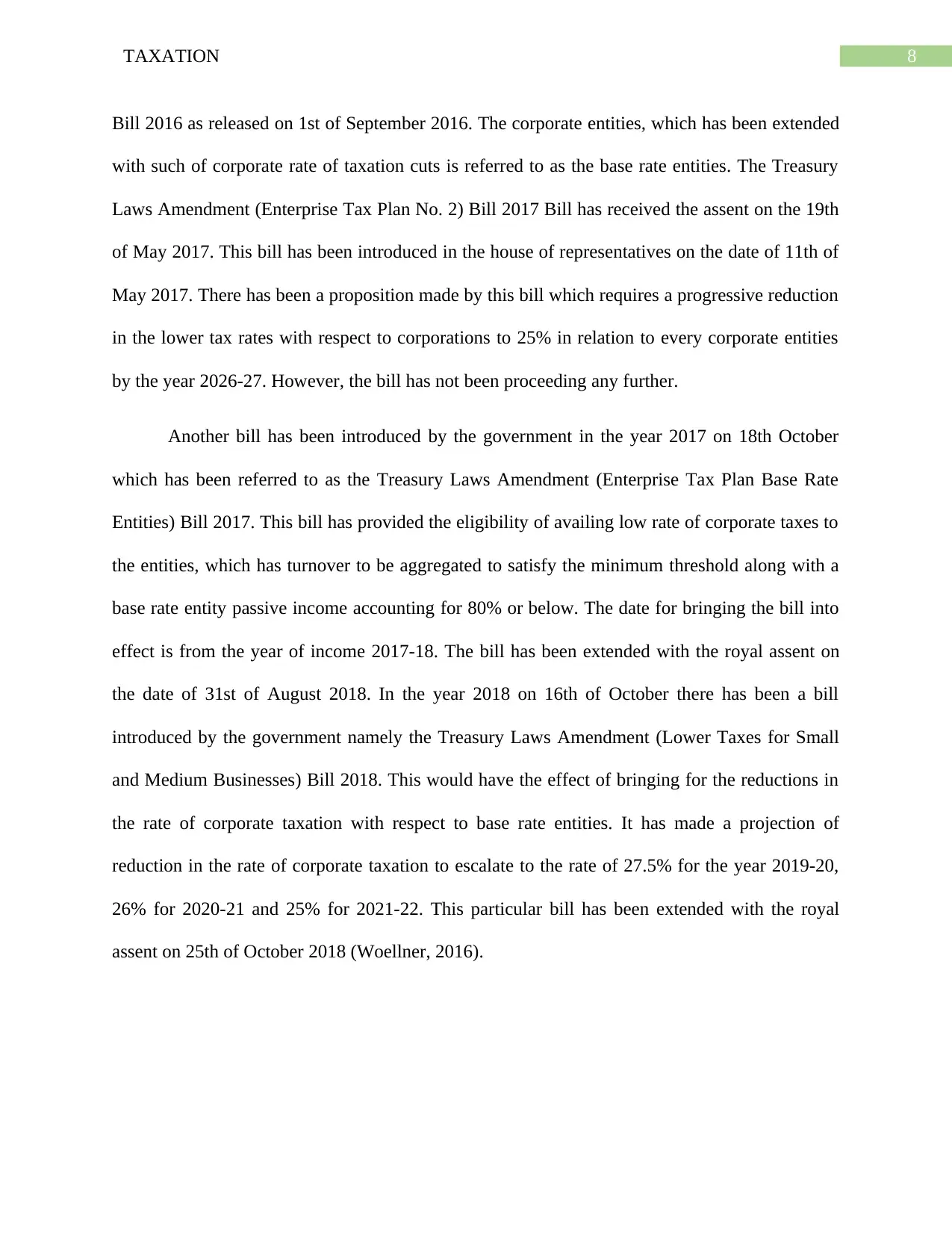
8TAXATION
Bill 2016 as released on 1st of September 2016. The corporate entities, which has been extended
with such of corporate rate of taxation cuts is referred to as the base rate entities. The Treasury
Laws Amendment (Enterprise Tax Plan No. 2) Bill 2017 Bill has received the assent on the 19th
of May 2017. This bill has been introduced in the house of representatives on the date of 11th of
May 2017. There has been a proposition made by this bill which requires a progressive reduction
in the lower tax rates with respect to corporations to 25% in relation to every corporate entities
by the year 2026-27. However, the bill has not been proceeding any further.
Another bill has been introduced by the government in the year 2017 on 18th October
which has been referred to as the Treasury Laws Amendment (Enterprise Tax Plan Base Rate
Entities) Bill 2017. This bill has provided the eligibility of availing low rate of corporate taxes to
the entities, which has turnover to be aggregated to satisfy the minimum threshold along with a
base rate entity passive income accounting for 80% or below. The date for bringing the bill into
effect is from the year of income 2017-18. The bill has been extended with the royal assent on
the date of 31st of August 2018. In the year 2018 on 16th of October there has been a bill
introduced by the government namely the Treasury Laws Amendment (Lower Taxes for Small
and Medium Businesses) Bill 2018. This would have the effect of bringing for the reductions in
the rate of corporate taxation with respect to base rate entities. It has made a projection of
reduction in the rate of corporate taxation to escalate to the rate of 27.5% for the year 2019-20,
26% for 2020-21 and 25% for 2021-22. This particular bill has been extended with the royal
assent on 25th of October 2018 (Woellner, 2016).
Bill 2016 as released on 1st of September 2016. The corporate entities, which has been extended
with such of corporate rate of taxation cuts is referred to as the base rate entities. The Treasury
Laws Amendment (Enterprise Tax Plan No. 2) Bill 2017 Bill has received the assent on the 19th
of May 2017. This bill has been introduced in the house of representatives on the date of 11th of
May 2017. There has been a proposition made by this bill which requires a progressive reduction
in the lower tax rates with respect to corporations to 25% in relation to every corporate entities
by the year 2026-27. However, the bill has not been proceeding any further.
Another bill has been introduced by the government in the year 2017 on 18th October
which has been referred to as the Treasury Laws Amendment (Enterprise Tax Plan Base Rate
Entities) Bill 2017. This bill has provided the eligibility of availing low rate of corporate taxes to
the entities, which has turnover to be aggregated to satisfy the minimum threshold along with a
base rate entity passive income accounting for 80% or below. The date for bringing the bill into
effect is from the year of income 2017-18. The bill has been extended with the royal assent on
the date of 31st of August 2018. In the year 2018 on 16th of October there has been a bill
introduced by the government namely the Treasury Laws Amendment (Lower Taxes for Small
and Medium Businesses) Bill 2018. This would have the effect of bringing for the reductions in
the rate of corporate taxation with respect to base rate entities. It has made a projection of
reduction in the rate of corporate taxation to escalate to the rate of 27.5% for the year 2019-20,
26% for 2020-21 and 25% for 2021-22. This particular bill has been extended with the royal
assent on 25th of October 2018 (Woellner, 2016).
⊘ This is a preview!⊘
Do you want full access?
Subscribe today to unlock all pages.

Trusted by 1+ million students worldwide
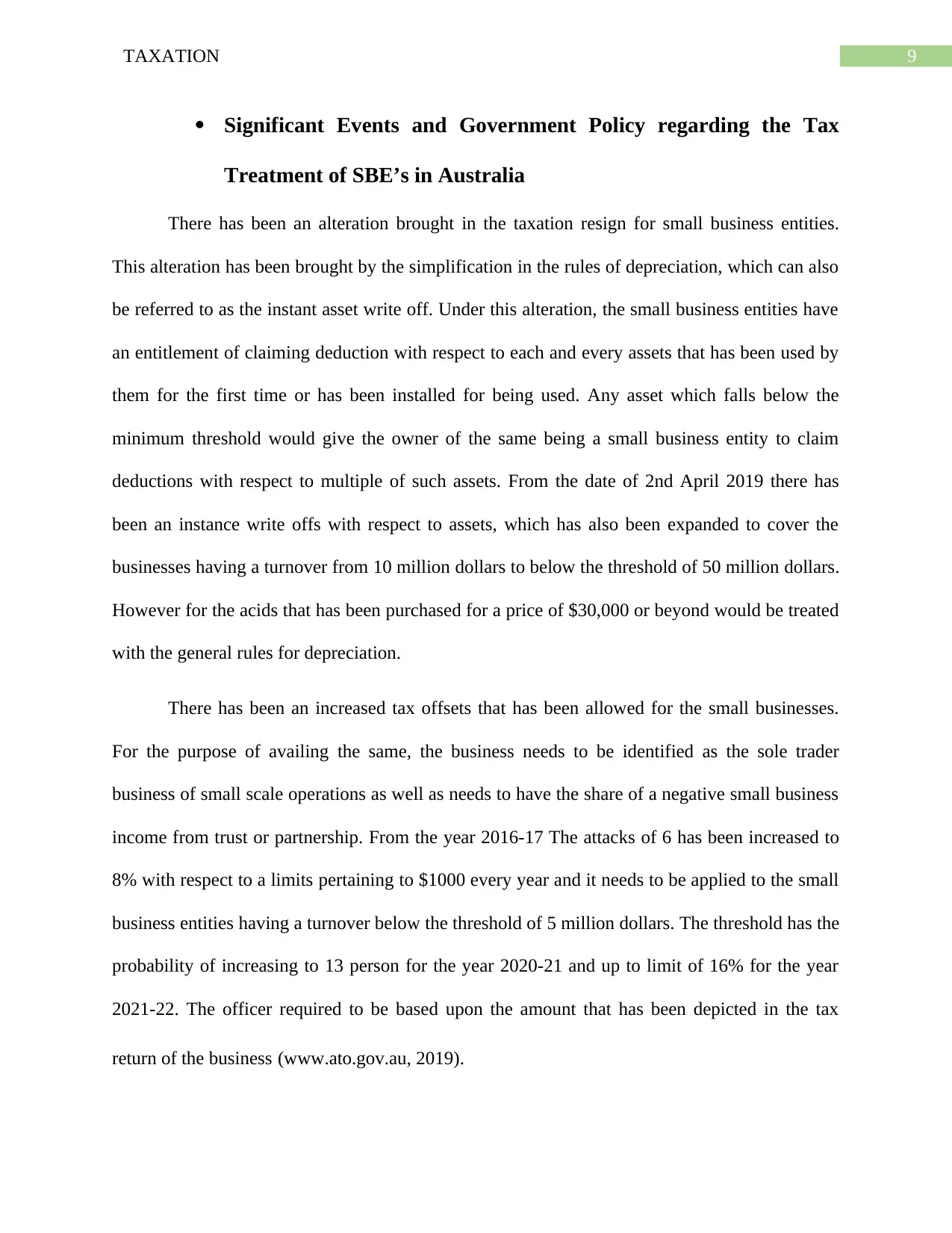
9TAXATION
Significant Events and Government Policy regarding the Tax
Treatment of SBE’s in Australia
There has been an alteration brought in the taxation resign for small business entities.
This alteration has been brought by the simplification in the rules of depreciation, which can also
be referred to as the instant asset write off. Under this alteration, the small business entities have
an entitlement of claiming deduction with respect to each and every assets that has been used by
them for the first time or has been installed for being used. Any asset which falls below the
minimum threshold would give the owner of the same being a small business entity to claim
deductions with respect to multiple of such assets. From the date of 2nd April 2019 there has
been an instance write offs with respect to assets, which has also been expanded to cover the
businesses having a turnover from 10 million dollars to below the threshold of 50 million dollars.
However for the acids that has been purchased for a price of $30,000 or beyond would be treated
with the general rules for depreciation.
There has been an increased tax offsets that has been allowed for the small businesses.
For the purpose of availing the same, the business needs to be identified as the sole trader
business of small scale operations as well as needs to have the share of a negative small business
income from trust or partnership. From the year 2016-17 The attacks of 6 has been increased to
8% with respect to a limits pertaining to $1000 every year and it needs to be applied to the small
business entities having a turnover below the threshold of 5 million dollars. The threshold has the
probability of increasing to 13 person for the year 2020-21 and up to limit of 16% for the year
2021-22. The officer required to be based upon the amount that has been depicted in the tax
return of the business (www.ato.gov.au, 2019).
Significant Events and Government Policy regarding the Tax
Treatment of SBE’s in Australia
There has been an alteration brought in the taxation resign for small business entities.
This alteration has been brought by the simplification in the rules of depreciation, which can also
be referred to as the instant asset write off. Under this alteration, the small business entities have
an entitlement of claiming deduction with respect to each and every assets that has been used by
them for the first time or has been installed for being used. Any asset which falls below the
minimum threshold would give the owner of the same being a small business entity to claim
deductions with respect to multiple of such assets. From the date of 2nd April 2019 there has
been an instance write offs with respect to assets, which has also been expanded to cover the
businesses having a turnover from 10 million dollars to below the threshold of 50 million dollars.
However for the acids that has been purchased for a price of $30,000 or beyond would be treated
with the general rules for depreciation.
There has been an increased tax offsets that has been allowed for the small businesses.
For the purpose of availing the same, the business needs to be identified as the sole trader
business of small scale operations as well as needs to have the share of a negative small business
income from trust or partnership. From the year 2016-17 The attacks of 6 has been increased to
8% with respect to a limits pertaining to $1000 every year and it needs to be applied to the small
business entities having a turnover below the threshold of 5 million dollars. The threshold has the
probability of increasing to 13 person for the year 2020-21 and up to limit of 16% for the year
2021-22. The officer required to be based upon the amount that has been depicted in the tax
return of the business (www.ato.gov.au, 2019).
Paraphrase This Document
Need a fresh take? Get an instant paraphrase of this document with our AI Paraphraser
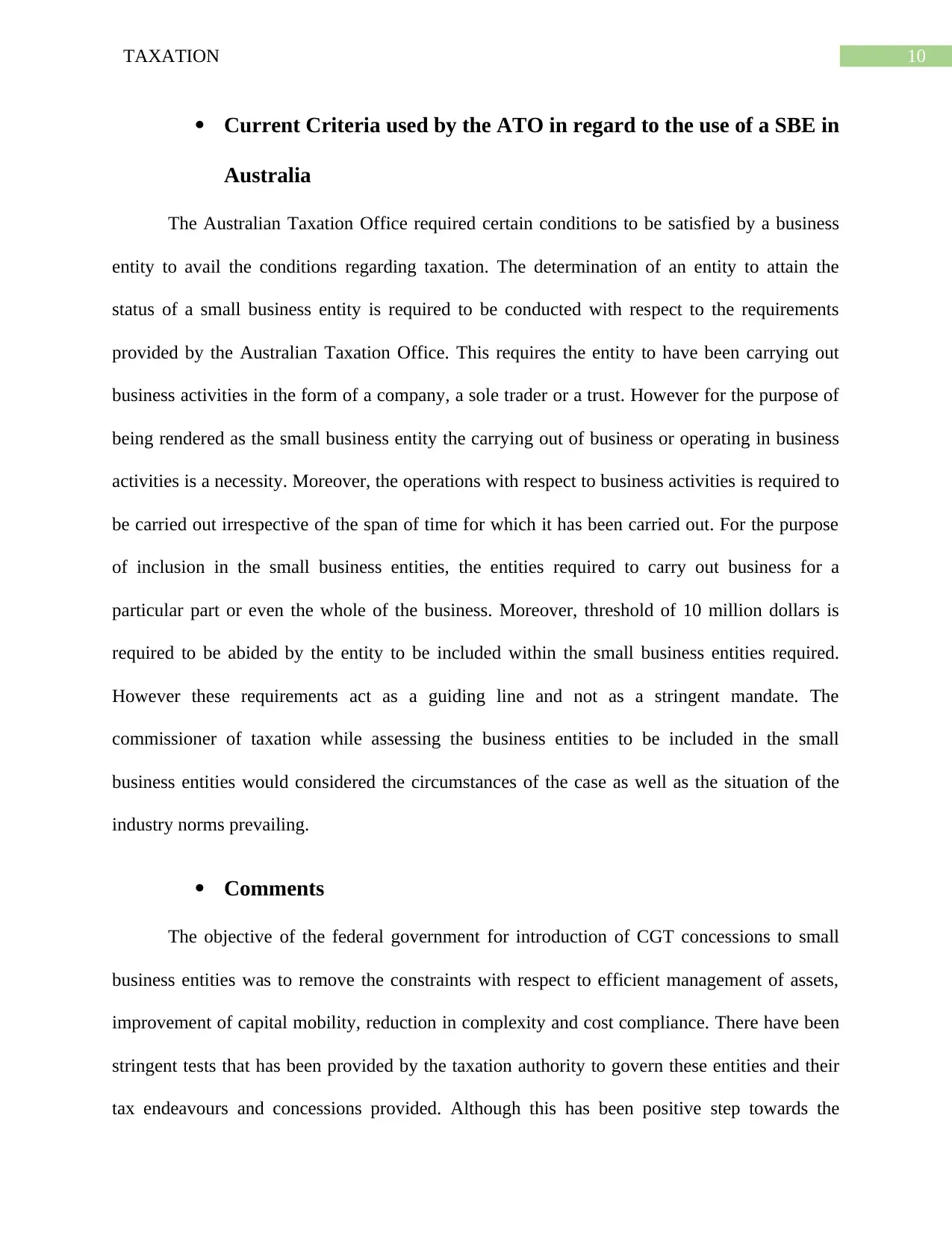
10TAXATION
Current Criteria used by the ATO in regard to the use of a SBE in
Australia
The Australian Taxation Office required certain conditions to be satisfied by a business
entity to avail the conditions regarding taxation. The determination of an entity to attain the
status of a small business entity is required to be conducted with respect to the requirements
provided by the Australian Taxation Office. This requires the entity to have been carrying out
business activities in the form of a company, a sole trader or a trust. However for the purpose of
being rendered as the small business entity the carrying out of business or operating in business
activities is a necessity. Moreover, the operations with respect to business activities is required to
be carried out irrespective of the span of time for which it has been carried out. For the purpose
of inclusion in the small business entities, the entities required to carry out business for a
particular part or even the whole of the business. Moreover, threshold of 10 million dollars is
required to be abided by the entity to be included within the small business entities required.
However these requirements act as a guiding line and not as a stringent mandate. The
commissioner of taxation while assessing the business entities to be included in the small
business entities would considered the circumstances of the case as well as the situation of the
industry norms prevailing.
Comments
The objective of the federal government for introduction of CGT concessions to small
business entities was to remove the constraints with respect to efficient management of assets,
improvement of capital mobility, reduction in complexity and cost compliance. There have been
stringent tests that has been provided by the taxation authority to govern these entities and their
tax endeavours and concessions provided. Although this has been positive step towards the
Current Criteria used by the ATO in regard to the use of a SBE in
Australia
The Australian Taxation Office required certain conditions to be satisfied by a business
entity to avail the conditions regarding taxation. The determination of an entity to attain the
status of a small business entity is required to be conducted with respect to the requirements
provided by the Australian Taxation Office. This requires the entity to have been carrying out
business activities in the form of a company, a sole trader or a trust. However for the purpose of
being rendered as the small business entity the carrying out of business or operating in business
activities is a necessity. Moreover, the operations with respect to business activities is required to
be carried out irrespective of the span of time for which it has been carried out. For the purpose
of inclusion in the small business entities, the entities required to carry out business for a
particular part or even the whole of the business. Moreover, threshold of 10 million dollars is
required to be abided by the entity to be included within the small business entities required.
However these requirements act as a guiding line and not as a stringent mandate. The
commissioner of taxation while assessing the business entities to be included in the small
business entities would considered the circumstances of the case as well as the situation of the
industry norms prevailing.
Comments
The objective of the federal government for introduction of CGT concessions to small
business entities was to remove the constraints with respect to efficient management of assets,
improvement of capital mobility, reduction in complexity and cost compliance. There have been
stringent tests that has been provided by the taxation authority to govern these entities and their
tax endeavours and concessions provided. Although this has been positive step towards the

11TAXATION
improvement of the small business entities but it has a probability of revenue loss being caused
to the taxation authorities by the large entities by taxation concessions by declaring themselves to
be small business entities with the statement of their turnover and other requisites (Tanti, 2018).
improvement of the small business entities but it has a probability of revenue loss being caused
to the taxation authorities by the large entities by taxation concessions by declaring themselves to
be small business entities with the statement of their turnover and other requisites (Tanti, 2018).
⊘ This is a preview!⊘
Do you want full access?
Subscribe today to unlock all pages.

Trusted by 1+ million students worldwide
1 out of 15
Related Documents
Your All-in-One AI-Powered Toolkit for Academic Success.
+13062052269
info@desklib.com
Available 24*7 on WhatsApp / Email
![[object Object]](/_next/static/media/star-bottom.7253800d.svg)
Unlock your academic potential
Copyright © 2020–2025 A2Z Services. All Rights Reserved. Developed and managed by ZUCOL.





